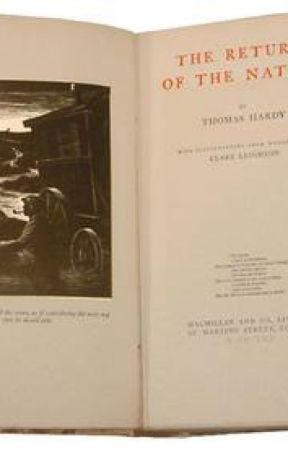Had a looker-on been posted in the immediate vicinity of the barrow, he would have learned that these persons were boys and men of the neighbouring hamlets. Each, as he ascended the barrow, had been heavily laden with furze faggots, carried upon the shoulder by means of a long stake sharpened at each end for impaling them easily—two in front and two behind. They came from a part of the heath a quarter of a mile to the rear, where furze almost exclusively prevailed as a product.
Every individual was so involved in furze by his method of carrying the faggots that he appeared like a bush on legs till he had thrown them down. The party had marched in trail, like a travelling flock of sheep; that is to say, the strongest first, the weak and young behind.
The loads were all laid together, and a pyramid of furze thirty feet in circumference now occupied the crown of the tumulus, which was known as Rainbarrow for many miles round. Some made themselves busy with matches, and in selecting the driest tufts of furze, others in loosening the bramble bonds which held the faggots together. Others, again, while this was in progress, lifted their eyes and swept the vast expanse of country commanded by their position, now lying nearly obliterated by shade. In the valleys of the heath nothing save its own wild face was visible at any time of day; but this spot commanded a horizon enclosing a tract of far extent, and in many cases lying beyond the heath country. None of its features could be seen now, but the whole made itself felt as a vague stretch of remoteness.
While the men and lads were building the pile, a change took place in the mass of shade which denoted the distant landscape. Red suns and tufts of fire one by one began to arise, flecking the whole country round. They were the bonfires of other parishes and hamlets that were engaged in the same sort of commemoration. Some were distant, and stood in a dense atmosphere, so that bundles of pale straw-like beams radiated around them in the shape of a fan. Some were large and near, glowing scarlet-red from the shade, like wounds in a black hide. Some were Maenades, with winy faces and blown hair. These tinctured the silent bosom of the clouds above them and lit up their ephemeral caves, which seemed thenceforth to become scalding caldrons. Perhaps as many as thirty bonfires could be counted within the whole bounds of the district; and as the hour may be told on a clock-face when the figures themselves are invisible, so did the men recognize the locality of each fire by its angle and direction, though nothing of the scenery could be viewed.
The first tall flame from Rainbarrow sprang into the sky, attracting all eyes that had been fixed on the distant conflagrations back to their own attempt in the same kind. The cheerful blaze streaked the inner surface of the human circle—now increased by other stragglers, male and female—with its own gold livery, and even overlaid the dark turf around with a lively luminousness, which softened off into obscurity where the barrow rounded downwards out of sight. It showed the barrow to be the segment of a globe, as perfect as on the day when it was thrown up, even the little ditch remaining from which the earth was dug. Not a plough had ever disturbed a grain of that stubborn soil. In the heath's barrenness to the farmer lay its fertility to the historian. There had been no obliteration, because there had been no tending.
It seemed as if the bonfire-makers were standing in some radiant upper story of the world, detached from and independent of the dark stretches below. The heath down there was now a vast abyss, and no longer a continuation of what they stood on; for their eyes, adapted to the blaze, could see nothing of the deeps beyond its influence. Occasionally, it is true, a more vigorous flare than usual from their faggots sent darting lights like aides-de-camp down the inclines to some distant bush, pool, or patch of white sand, kindling these to replies of the same colour, till all was lost in darkness again. Then the whole black phenomenon beneath represented Limbo as viewed from the brink by the sublime Florentine in his vision, and the muttered articulations of the wind in the hollows were as complaints and petitions from the "souls of mighty worth" suspended therein.

YOU ARE READING
The Return of the Native (Completed)
ClassicsThe Return of the Native is Thomas Hardy's sixth published novel. It first appeared in the magazine Belgravia, a publication known for its sensationalism, and was presented in twelve monthly installments from January to December 1878. Because of the...
